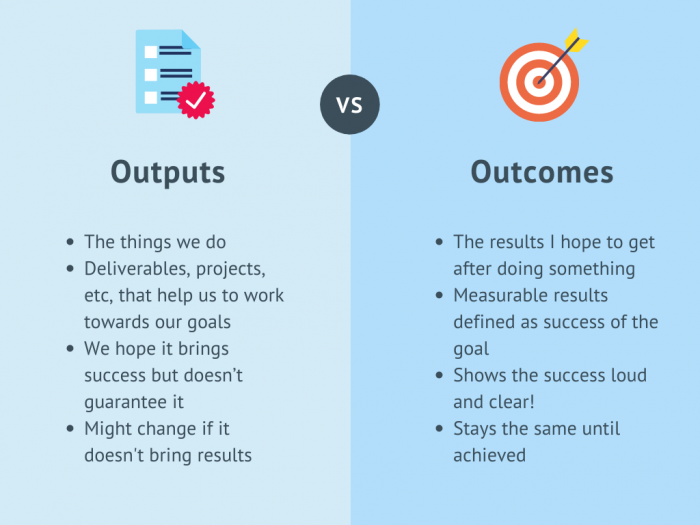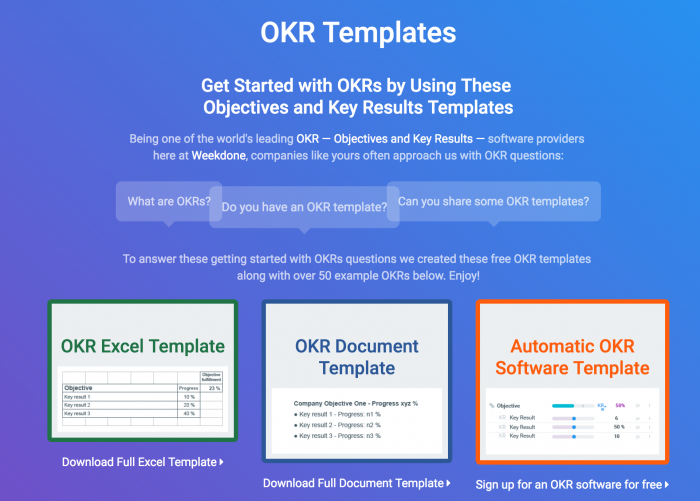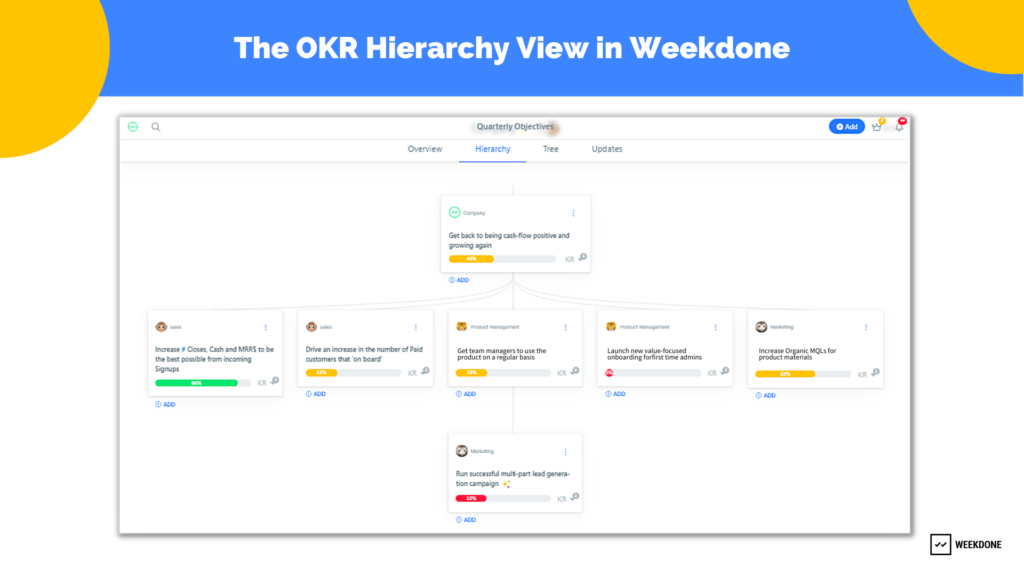Marketing is often misunderstood – because it takes time for marketing initiatives to have an impact and translate to business results. The best way to create effective marketing strategies is to set Objectives and Key Results (OKRs) from the beginning – because ROI is inherently linked to marketing OKRs that are created.
While you may find it easy, as a marketer, to decide on desired outcomes (such as an increase in pipeline, demand generation, brand awareness, etc.) do you know how you are going to achieve these outcomes?
The key challenge that all marketers face is identifying methods, tactics, and initiatives that need to be adopted to deliver results. And in the hustle to accomplish all goals, marketing teams invariably lose focus and find it difficult to deliver results linked to their objectives.
👉 Watch this video to find how to create OKRs for Marketing teams,
This article provides you with a better understanding of how to align your marketing efforts and focus on outcomes (not just output) to deliver real and measurable change. It also provides marketing OKR examples that serve as a guide to effectively set, track, and measure your objectives and key results.
Why and How to Set OKRs for Marketing
Modern marketers are adopting the OKR framework. Because it helps them streamline their marketing goals and ensures different focus areas of marketing (such as digital, content, social, PR, product, etc.) deliver impactful results.
Why best-in-class marketers believe in marketing OKRs
Marketers adopt the OKR framework because it allows them to stay aligned with the other teams, focus on outcomes (instead of output), and helps to translate high-level goals to measurable results.
Align with other teams and offer transparency
Marketing team goals are intricately linked with the goals of other teams such as sales, customer success, and product teams. Making team alignment an important factor.
Aligning marketing OKRs with the objectives of other teams and the company helps achieve impactful results. It is important to discuss and share OKRs so that there’s transparency to understand how marketing initiatives provide value and generate revenue.
For instance, a company’s goal to increase revenue translates to different objectives for different teams. In this case, one of the marketing OKRs would be to improve conversions with a key result such as optimizing the top five landing pages to convert a specified percentage of new users to paid customers.
To achieve this result, it could require initiating tasks such as refining the content, changing the design layout, and increasing promotion (through new content assets linked to the landing page, demand generation campaigns, or social media).
Communicating these initiatives and the key result ensures alignment between teams, provides transparency about the results expected, and the value that the marketing team can deliver.
Focus on the output and not just the outcome
By creating marketing OKRs correctly, it becomes easier to focus on the output instead of only the outcome. While output refers to the initiative to achieve goals, an outcome is a measurable result, based on the output you deliver.
For instance, your marketing objective could be to improve lead generation, that’s output. The outcome, in this case, would be to create a lead generation campaign strategy that increases inbound MQLs from 100 to 300 per quarter.
Translate high-level goals into measurable results
The benefit of creating marketing OKRs is that it helps quantify goals and ensures results are measurable. While Key Results are not always directly connected to individual goals (day-to-day tasks), they must be measurable and linked to an objective.
For example, one of your digital marketing OKRs may be to improve social media engagement and traffic. To make this goal measurable, your key results could be to:
- KR1: Increase CTR from 5% to 8%
- KR2: Maintain and exceed average weekly interactions (comments, shares) of 50
- KR3: Expand the audience base from 5,00 to 8,00 in the quarter.
How to Write OKRs for Marketing
Marketers work under a lot of pressure. Expectations are high and it typically takes longer than a quarter to observe any impact on conversions, ROI, and marketing strategy effectiveness.
The best practice, when writing marketing OKRs, is to learn from past performance (what has worked and not worked), focus on defined problems, and prioritize initiatives.
Some of the steps to guide you through the process of creating marketing OKRs include:
1. Discuss with the team – Begin by asking, what have you learned from the previous quarter, what worked, and what did not work? Based on the data that is tracked, which metrics are high-performing, and which are those that can be improved? A discussion around these questions can be a good starting point and a great way to get the entire team to believe in the OKRs that are created.
2. Draft an objective – When writing a marketing OKR, start with the question, what is the high-impact initiative that can solve the defined problem? The answer to this will give you direction as to what your objective should be based on the goal you are trying to achieve.
3. Define the key results – With a clear objective defined, the next step is to document the key results you want to achieve. Ask the question, what are the measurable outcomes you want to accomplish? Keep in mind that your key results need to be actionable and time-bound and that they are not tasks that need to be completed.
4. Prioritize initiatives – To ensure your OKRs are implemented successfully, it is important to understand the tasks that need to be completed. Prioritizing tasks and conducting Weekly Check-Ins is a great way to ensure the progress toward a goal is on track.
Are you ready to create and implement your company OKRs? Get started with these marketing OKR templates.
How to Stay Focused in the Process of Creating Marketing OKRs
Creating marketing OKRs can be challenging. Take a step back and follow a logical process – from bigger goals and visions to smaller actionable steps. Here are some pointers to help you stay focused through your goal-setting process:
- Start by defining the big-picture impact (what are you trying to achieve in the long term).
- Focus on measurable outcomes that the team can evaluate weekly (quarterly OKRs).
- Your quarterly OKRs should connect directly to long-term goals.
- Your Key Results must serve as measurable proof of the impact of your quarterly initiatives.
- You must analyze and update your Key Results every week and prioritize weekly Plans.
Whether you’re an OKR champion or a beginner, stay on track by consulting OKR experts. Find out how other companies are using OKR software programs to achieve results.
11 Marketing OKR Examples: Raise the Bar on Marketing ROI
Marketing has many facets. It focuses on several areas such as product, content, SEO, social media, email, branding, and inbound/outbound marketing. Depending on the needs of your organization, your marketing OKRs could be different.
Choose from these examples in different strategic areas of marketing:
Strategic Marketing
Objective: Improve the presence on relevant review websites, forums, and groups to nurture leads with high buying intent.
Key Results:
KR1: Increase the number of positive brand mentions on the website from 3,000 to 6,000 (30-day average)
KR2: Increase the number of published reviews from 15 to 45 on review sites
KR3: Achieve 60+ demo requests from discussion forums & groups
PR and Branding
Objective: Establish a strong brand presence in the new region to position the brand with other big local competitors
Key Results:
KR1: Get 5 earned placements through press releases
KR2: Collaborate with industry influencers that drive pre-orders worth $100,000
KR3: Achieve 5,000 mentions on social media and position the brand next to the biggest local competitors
Product Marketing
Objective: Simplify and clarify the messaging and overall presentation to make the product more appealing to startups
Key Results:
KR1: 25 on-site user-testing sessions to understand early-stage product misunderstandings
KR2: Test 10 of our recent infographics and slide decks for customer understanding
KR3: Send a user survey to signups in the last quarter and get 500 responses
Inbound Marketing
Objective: Run demand generation campaigns (drip and general) across channels to generate more Marketing Qualified Leads (MQLs)
Key Results:
KR1: Increase email marketing MQLs from 100 to 150
KR2: Increase AdWords MQLs from 70 to 100
KR3: Increase organic search ranking to increase MQLs from 40 to 60
Outbound Marketing
Objective: Revamp the approach to promoting virtual events to improve outbound marketing performance
Key Results:
KR1: Obtain 50+ qualified leads from webinars
KR2: Collect 200+ prospects from conferences and networking events (virtual, hybrid)
KR3: Achieve 100+ qualified leads from the outreach campaign
Partner Marketing
Objective: Improve community management to encourage positive word-of-mouth marketing
Key Results:
KR1: Increase the number of referrals from clients by 2% to 15%
KR2: Increase the signups for the newsletter from 1,500 to 3,000 people
KR3: Obtain at least 15 testimonials (video or text) in the quarter
Email Marketing
Objective: Successfully implement the weekly newsletter to improve brand awareness
Key Results:
KR1: Finalize 12 topic areas for the announcement banners
KR2: Achieve 50,000 subscribers
KR3: Increase the CTR to above the industry average of 3.5%
Content Marketing
Objective: Improve content distribution via forums and communities to improve the connection to the brand
Key Results:
KR1: Research 15 relevant communities on platforms such as LinkedIn
KR2: Prepare 40 post templates to distribute blog articles in the comments section
KR3: Increase blog traffic from 5,000 to 8,000 new visitors per month from forums and communities
SEO
Objective: Improve the SEO rankings of cornerstone content to improve brand visibility
Key Results:
KR1: Ensure 10 cornerstone content articles have 5 or more backlinks
KR2: Publish 15 guest blog posts linking them to key content assets on relevant sites
KR3: Ensure 15 cornerstone content articles have at least 10 internal links
PPC Marketing
Objective: Improve Google Ads campaigns in the North American market to improve brand presence locally
Key Results:
KR1: Run 10 Google Ads campaigns for 10 different target groups in the U.S.
KR2: Increase paid new visitors in the U.S. from 1,000 to 2,500 per month
KR3: Increase CTR of ads from 1% to 2%
Social Media Marketing (SMM)
Objective: Increase community engagement on social media pages to enhance connection with the brand
Key Results:
KR1: Increase the average number of comments under each post from 2 to 10
KR2: Convert 60% of new leads coming from influencers
KR3: Increase average views on top 5 LinkedIn articles from 5,000 to 10,000
👉 If you want more guidance in your goal-setting process, check out these 25+ marketing OKR examples,
Set, Track, and Measure Marketing OKRs with Weekdone
The OKR framework is a goal-setting system that helps your teams set, track, and achieve their most ambitious goals. This method provides clarity on how daily tasks and initiatives connect to the bigger picture.
Weekdone provides a hierarchical structure that makes it easy to set OKRs at company, department, and team level. This ensures that everyone understands how the goals are aligned and structured. To see the progress of everyone’s initiatives, you can link weekly plans to Objectives.
Keep track of company goals by setting Weekly Planning and Quarterly Objectives on Weekdone. The OKR tool is a hassle-free goal-setting platform that allows managers and team members to get an overview of objectives and key results.
With weekly status reports and reviews of long-term quarterly goals, it provides a feedback system that can help you stay aligned in every stage of the goal-setting process.
Find out how you can improve your marketing ROI by setting clear goals, measuring the right metrics, and aligning your team.
Don’t lose sight of your marketing team’s goals
Take a walkthrough of Weekdone
The important aspect about the OKR methodology is that it keeps everyone focused on what matters most and helps to “Measure What Matters”.
Whether you want to successfully implement your initiatives or align your marketing objectives to the company’s goals, the OKR framework empowers you to achieve optimal results and deliver real value.
Are you ready to create Marketing OKRs?




